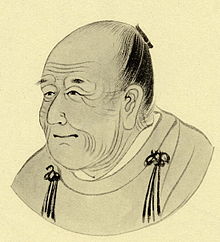Takeda Izumo I.
Takeda Izumo I. ( Japanese 竹田 出 雲 ; date and place of birth unknown; † 1747 in Ōsaka ) was a Japanese puppet theater director and author.
He was either the son or the brother of Takeda Ōmie, a manufacturer of mechanical dolls ( karakuri ), and initially worked on the demonstrations of these dolls in the Dōtonbori entertainment district of Ōsaka. In 1704 he began to work at the Takemoto Bunraku Theater, where he rose to Zamoto , the first puppeteer, a year later . In the following years he took on more and more management tasks of the theater and was responsible for ensuring that both the narrator ( Tayū ) as well as the musicians and puppeteers during the performances ( Degatari ) were visible to the audience. He also ensured that the dolls were dressed in more splendid costumes and that the stage design was richer. The mechanics of the dolls themselves were improved under his direction by adopting various devices from the Karakuri , which gave the dolls greater freedom of movement and from then on were guided by three, not one, puppeteer.
From 1723 Takeda began writing plays for the Bunraku Theater under the guidance of Chikamatsu Monzaemon . Of the eleven pieces that he wrote alone, the play Ashiya Dōman Ōuchi Kagami, also adapted from the Kabuki theater, was the most successful. As a co-author ( Gassaku ) he worked with Hasegawa Senshi and Hasegawa Bunkodō, among others. He was also involved in the creation of the play Sugawara Denju Tenarai Kagami , a historical drama ( Jidaimono ) performed in Japanese theaters to this day . As an author, he also used the names Takeda Senzengen I. and Takeda Geki II.
swell
- Martina Schönbein: The Michiyuki-Passagen in the Sewa-Jōruri of the playwright Chikamatsu Monzaemon (1653-1724): structure, literary stylistic devices and reception . Otto Harrassowitz Verlag, 1994, ISBN 9783447034340 , p. 273.
- Stanley Hochman: McGraw-Hill encyclopedia of world drama: an international reference work in 5 vol , Volume 1, 2nd edition, VNR AG, 1984, ISBN 9780070791695 , p. 3
- Samuel L. Leiter: Historical dictionary of Japanese traditional theater . Scarecrow Press, 2006, ISBN 9780810855274 , p. 16.
- Samuel L. Leader: New Kabuki Encyclopedia. A Revised Adaptation of Kabuki Jiten . Greenwood Press, Westport Connecticut and London 1997, ISBN 0-313-29288-4 , p. 638.
- Hoshū Katsuragawa, Jacques Proust: Naufrage & tribulations d'un japonais dans la Russie de Catherine II: 1782-1792 . Editions Chandeigne, 2004, ISBN 9782906462984 , p. 50.
| personal data | |
|---|---|
| SURNAME | Takeda, Izumo |
| ALTERNATIVE NAMES | 竹田 出 雲 (Japanese) |
| BRIEF DESCRIPTION | Japanese puppet theater director and author |
| DATE OF BIRTH | 17th century |
| DATE OF DEATH | 1747 |
| Place of death | Osaka |
